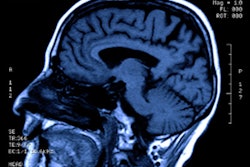MRI results suggest that the longer a patient has type 2 diabetes, the more brain volume is lost, according to research published online April 29 in Radiology. This was especially true for gray matter, which is associated with speech, motion, and memory.
In addition, contrary to common clinical belief, diabetes does not appear to be associated with small vessel ischemic disease, which is a major contributor to cognitive decline and dementia among the elderly, the researchers from several U.S. institutions concluded.
The findings confirm and add to previous studies indicating that "diabetes is associated most strongly and consistently with brain atrophy," especially in gray matter, wrote lead author Dr. R. Nick Bryan, PhD, professor of radiology at Perelman School of Medicine at the University of Pennsylvania, and colleagues (Radiology, April 29, 2014).
Diabetes epidemic
There are approximately 26 million people in the U.S. with diabetes, and 1.9 million are diagnosed with the disease annually, according the American Diabetes Association (ADA). The ADA estimates that as many as one in three American adults will have diabetes in the year 2050. Type 2 diabetes is the most common form of the disease, in which either the pancreas does not produce enough insulin or the cells ignore the insulin that is produced.
For their study, Bryan and colleagues used data from a substudy of the Action to Control Cardiovascular Risk in Diabetes (ACCORD); the randomized, controlled ACCORD trial included 10,251 people with type 2 diabetes. Called ACCORD-MIND (Memory in Diabetes), the substudy was performed from 2003 to 2005 to determine whether therapeutic interventions for diabetes would reduce cognitive decline and structural brain changes.
The researchers decided to analyze MRI scans performed on the ACCORD-MIND patients to see if there was a relationship between the length and severity of diabetes and structural brain changes.
The group reviewed 614 type 2 diabetic patients from ACCORD-MIND from four medical institutions (mean age, 62 years). Approximately 55% of the subjects were male, 80% were hypertensive, and 26% had a history of cardiovascular disease. The mean duration of disease among the subjects was 9.9 years.
All MR images were acquired on 1.5-tesla scanners using several imaging protocols, including 3D fast spoiled gradient-echo T1-weighted; 2D axial fast spin-echo fluid-attenuated inversion-recovery (FLAIR); and proton-density T2-weighted sequences.
Baseline severity of diabetes was evaluated by testing fasting plasma glucose levels, hemoglobin A1c levels, and duration of diabetes. Diabetes duration was calculated as time from a reported diagnosis to randomization in the ACCORD trial.
Brain volume
At baseline, mean volumes of total gray matter (463.8 cm3) and total white matter (463.6 cm3) were similar among study participants, the researchers found. There was very little abnormal gray matter (0.15 mL), with more abnormal white matter (2.02 mL).
Patients with a longer duration of diabetes had decreased volumes of total gray matter and abnormal gray matter. For example, a 10-year difference in diabetes duration was predictive of a 4.28-cm3 difference in total gray-matter volume.
Bryan and colleagues estimated that for every 10 years of diabetes duration, the brain of a diabetic looks approximately two years older than that of a nondiabetic, in terms of gray-matter volume.
A longer duration of diabetes was also associated with a larger volume of abnormal tissue in the white matter and deep gray and white matter, when adjusted for age and intracranial volume.
In addition, higher fasting plasma glucose levels were significantly associated with smaller volumes of total gray and normal gray matter, as well as abnormal white matter. A 50-unit difference in blood glucose levels was predictive of a 2.65-cm3 volume difference in total gray matter, 3.00-cm3 difference in normal gray matter, and 0.3-cm3 difference in abnormal white matter.
No connection to ischemic disease
While the study linked longer diabetes duration or severity with brain atrophy, the researchers did not find a correlation between diabetes and white-matter lesion volume, which is one of the major MRI markers for small vessel ischemic disease (SVID).
"Therefore, our study results provided additional support for the position that, despite common clinical perception, diabetes is not directly related to SVID," the authors wrote. "Our data, however, do not preclude associations between white-matter lesions and other consequences of diabetes, such as nephropathy or comorbid conditions such as hypertension."
The findings may have implications for the future decline of cognitive function in patients with diabetes, Bryan and colleagues added. The results also raise the possibility that such cognitive changes might be related to neurodegenerative disorders such as Alzheimer's disease, rather than vascular dementia.
The authors did cite several limitations of the study, including the fact that the cohort only included patients with diabetes, so the findings could not be compared with a nondiabetic population.



.fFmgij6Hin.png?auto=compress%2Cformat&fit=crop&h=100&q=70&w=100)




.fFmgij6Hin.png?auto=compress%2Cformat&fit=crop&h=167&q=70&w=250)











